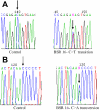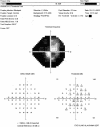Myocilin mutations among POAG patients from two populations of Tamil Nadu, South India, a comparative analysis
- PMID: 22194650
- PMCID: PMC3244482
Myocilin mutations among POAG patients from two populations of Tamil Nadu, South India, a comparative analysis
Abstract
Purpose: Primary open angle glaucoma (POAG) is the most common type of glaucoma. Among the POAG genes identified so far, myocilin (MYOC) is the most frequently mutated gene in POAG patients worldwide. The MYOC Gln48His mutation is unique among Indian POAG patients. This mutation has not been observed in some populations within India and in other populations worldwide. The objectives of this work were to characterize and compare the mutation spectrum among POAG patients from two places of South India and identify the occurrence and prevalence of Gln48His mutation in our study populations.
Methods: One hundred-one (101) POAG patients from Chennai, South India were recruited for the study. Earlier, 100 patients from the southernmost part of India, Kanyakumari district, were screened. MYOC was screened by polymerase chain reaction based single stand conformation polymorphism (PCR-SSCP) methodology. DNA sequencing of deviant samples was performed. Secondary structures of the proteins with amino acid sequence variations were predicted.
Results: The mutation frequency of MYOC among POAG patients in Chennai was 2%. Three types of mutations were observed. The MYOC Gln48His mutation was observed among 2 POAG patients from Chennai. However, absence of this mutation among patients from Kanyakumari suggests possible involvement of demographic factors in disease causation via this mutation. Two heterozygous sequence variants, Thr353Ile and Asn480Lys, in the same exon (exon III) of MYOC were observed in one POAG patient who had a severe disease phenotype. This is the first such report of a compound heterozygote individual with two mutations in the same exon of MYOC.
Conclusions: The presence of mutations at a rate similar to other studies suggests the causative role of MYOC among POAG patients from Chennai. Screening of more patients and families from all parts of India is required to identify the actual frequency of the Gln48His mutation and thus highlight its importance. The compound heterozygote with a severe disease phenotype reiterates the importance of MYOC in certain POAG patients.
Figures



Similar articles
-
Myocilin mutations among primary open angle glaucoma patients of Kanyakumari district, South India.Mol Vis. 2007 Apr 2;13:497-503. Mol Vis. 2007. PMID: 17417611 Free PMC article.
-
Mutations in MYOC gene of Indian primary open angle glaucoma patients.Mol Vis. 2002 Nov 15;8:442-8. Mol Vis. 2002. PMID: 12447164
-
Comprehensive analysis of myocilin variants in east Indian POAG patients.Mol Vis. 2012;18:1548-57. Epub 2012 Jun 13. Mol Vis. 2012. PMID: 22736945 Free PMC article.
-
Genetic dissection of myocilin glaucoma.Hum Mol Genet. 2004 Apr 1;13 Spec No 1:R91-102. doi: 10.1093/hmg/ddh074. Epub 2004 Feb 5. Hum Mol Genet. 2004. PMID: 14764620 Review.
-
Prevalence of MYOC risk variants for glaucoma in different populations.Acta Ophthalmol. 2021 Nov;99(7):e1090-e1097. doi: 10.1111/aos.14738. Epub 2021 Jan 9. Acta Ophthalmol. 2021. PMID: 33421356
Cited by
-
Compound heterozygote myocilin mutations in a pedigree with high prevalence of primary open-angle glaucoma.Mol Vis. 2012;18:3064-9. Epub 2012 Dec 28. Mol Vis. 2012. PMID: 23304066 Free PMC article.
-
Identification of MYOC gene mutation and polymorphism in a large Malay family with juvenile-onset open angle glaucoma.Mol Vis. 2014 May 27;20:714-23. eCollection 2014. Mol Vis. 2014. PMID: 24883016 Free PMC article.
-
Single nucleotide polymorphism of MYOC affected the severity of primary open angle glaucoma.Int J Ophthalmol. 2013 Jun 18;6(3):264-8. doi: 10.3980/j.issn.2222-3959.2013.03.02. Print 2013. Int J Ophthalmol. 2013. PMID: 23826516 Free PMC article.
-
Interleukin-20 receptor expression in the trabecular meshwork and its implication in glaucoma.J Ocul Pharmacol Ther. 2014 Mar-Apr;30(2-3):267-76. doi: 10.1089/jop.2013.0187. Epub 2014 Jan 23. J Ocul Pharmacol Ther. 2014. PMID: 24455976 Free PMC article.
-
Common and rare myocilin variants: Predicting glaucoma pathogenicity based on genetics, clinical, and laboratory misfolding data.Hum Mutat. 2021 Aug;42(8):903-946. doi: 10.1002/humu.24238. Epub 2021 Jun 24. Hum Mutat. 2021. PMID: 34082484 Free PMC article. Review.
References
-
- Gupta N, Weinreb RN. New definitions of glaucoma. Curr Opin Ophthalmol. 1997;8:38–41. - PubMed
-
- Pang CP, Leung YF, Fan B, Baum L, Tong WC, Lee WS, Chua JKH, Fan DSP, Liu Y, Lam DSC. TIGR/ MYOC gene sequence alterations in individuals with and without primary open-angle glaucoma. Invest Ophthalmol Vis Sci. 2002;43:3231–5. - PubMed
-
- George R, Ve RS, Vijaya L. Glaucoma in India: Estimated Burden of Disease. J Glaucoma. 2010;19:391–7. - PubMed
Publication types
MeSH terms
Substances
LinkOut - more resources
Full Text Sources
